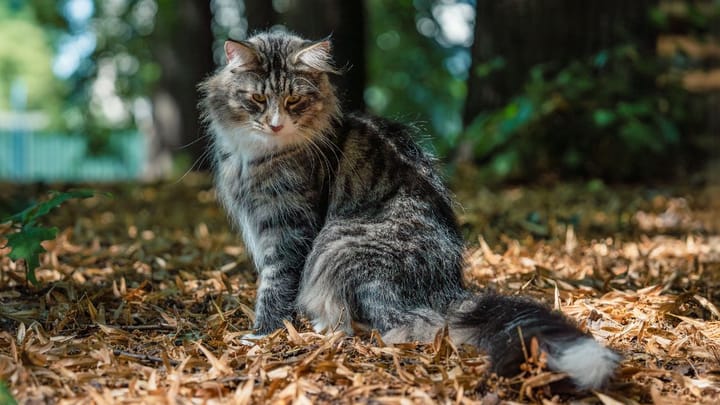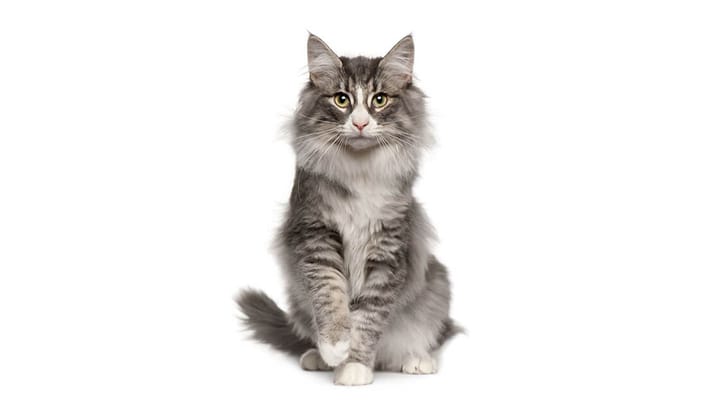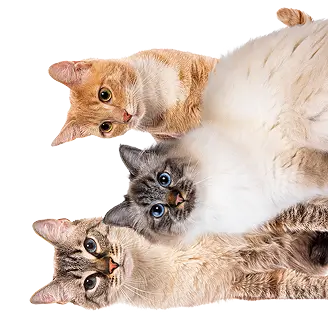Norwegian Forest cat
Other name: Skogkatt


"Norsk Skogkatt" in Norwegian literally translated into English is "northern forest cat". This name suits the Norwegian, since this is the perfect little Nordic feline. Shaped by the cold and harsh climate of Scandinavia, this rustic and robust breed is “natural”, meaning man did not intervene in their creation. From their beautiful coats to their strong constitution, through to their hunting skills, these cats demonstrate an adaptability that make them very popular, especially since they have a golden personality.
|
Life expectancy |
The Norwegian Forest cat has a life expectancy of between 14 and 16 years |
|
Temperament |
|
|
Adult size |
Female
Between 12 and 14 in
Male
Between 14 and 16 in
|
|
Adult weight |
Female
Between 9 and 13 lb
Male
Between 11 and 18 lb
|
|
Coat colour
Black, blue / grey-slate, ginger, cream, white, amber. The amber coat colour is unique to this breed and has only appeared recently. It comes in orange, honey and caramel. This colour takes several years to stabilize. |
Black White Cream Blue |
|
Type of coat
Long. |
Long |
|
Eye colour
All are accepted as long as they match the cat’s coat. |
Blue
Green
Yellow
Brown
Odd-eyed
|
|
Purchase price |
The Norwegian Forest cat costs between £250 and £800 |
Although it may look like the Maine Coon or Siberian, the Norwegian is physically slightly different from the first two. The main areas to notice? The head of the Norwegian forms an equilateral triangle, unlike the Maine Coon which has a very square muzzle and the Siberian’s muzzle which is more rounded. The eyes are also different: with slightly oblique almonds for the cat of Norway, almost round eyes for the Russian cat and more spaced apart on the American giant.
More details about the Norwegian Forest cat
Norwegian Forest cat: Origins and history
The first domestic cats from Scandinavia may have arrived with the Vikings, returning from their travels in the Middle East. The early Crusades also reportedly introduced long-haired cats from Europe, Turkey and Russia. Among these felines, those that were best adapted to the harsh and cold conditions of life were able to reproduce. This isolation led to a level of inbreeding. As a result, distinctive characteristics emerged and became the norm. The appearance of the Skogkatt thus remained very stable for several centuries, without mankind having anything to do with it.
It was not until the beginning of the 20th century that breeders decided to control and especially to protect the breed. Indeed, the growing presence of short-haired cats in Norway threatens, at this time, the traditional semi-wild long-haired cat that populates the country. After World War II, the most beautiful examples were gathered, sometimes even taken directly from the forests by these breeders who maintained the Norwegian Forest Cat and even granted it a pedigree. Today, Norway considers the Skogkatt as the country's official cat breed.
Physical characteristics of the Norwegian Forest cat
Longer and taller than the average domestic cat, the Skogkatt is robust, with a well-developed muscle and bone structure. Imposing, they are nonetheless elegant. Their long tail forms a well supplied plume. Their heads form an equilateral triangle with an almost straight profile. Their large oblique almond eyes and heart-shaped collar contribute to their soft demeanour. Moreover, the fur of this breed is, without question, its main characteristic. Double, it consists of a woolly and dense undercoat and a smooth, shiny and waterproof coat. Shorter on the shoulders, it goes down and along the flanks. The collar consists of longer fur. A pretty undercoat and hair in the ears and under the legs provide extra protection against the cold. In summer, the fur will adapt to milder temperatures by becoming shorter, even at the collar, and much less dense.
Norwegian Forest cat: Characteristics
Norwegian Forest cat: Behaviour
Breed compatibility Norwegian Forest cat
Norwegian Forest cat: Purchase price
Buying a Norwegian kitten will could cost anywhere between £250 and £800. Prices vary depending on pedigree, lineage, age and sex. It will cost on average £35 a month to provide for this cat’s needs.
Norwegian Forest cat: Shedding
Heavy !
Whilst the Norwegian Forest cat transitions between winter and summer coats, they shed a lot of hair.
Norwegian Forest cat: Grooming
Outside moulting periods, surprisingly, grooming a Norwegian Forest Cat is easy because the hair has little tendency to tangle. However, shedding periods will require daily brushing in order to remove the dead hair, which is in abundance during the changing seasons.
Norwegian Forest cat: Health
The Norwegian Forest Cat lives for 15 years on average.
Very robust, the cold does not scare this cat. And as temperatures warm up in the spring, they adapt the thickness of their coats.
These cats don’t put on weight too easily as long as they have enough opportunities to climb and move.
- Hypertrophic cardiomyopathy increases the volume of the left ventricle walls of the heart, possibly causing heart failure.
- Dysplasia of the hip is a hereditary defect of the hip joint that can sometimes cause extreme pain, which can be both short or long term.
- Glycogenosis type IV is a genetic disorder specific to Norwegian cat. The disease is fatal at an early age and is incurable. There is a screening test. The only way to stop the disease is to control the breeding stock and reproduce only the healthy carriers.
Norwegian Forest cats can only be bred with cats of their own breed.
Do you want a Norwegian Forest cat cat ?
Frequently asked questions
Which is bigger: Maine Coon or Norwegian Forest cat?
Both breeds are very large for domestic cats but Maine Coons are the biggest cat breed in the world. Maine Coons are around 11-26 lbs while Norwegian Forest Cats are around 9-20 lbs.
Check out 5 cat breeds that look like big cats!
Are Norwegian Forest cats good pets?
Norwegian Forest cats are quite laid-back in personality, so they can be a great addition to a family with children or other pets. They do however, also enjoy their time alone and will prefer being handled on their own terms.
Find out which cat breeds are best for families with children!
Are Norwegian Forest cats aggressive?
Norwegian Forest cats are not known to be aggressive, but as with any animal, they do not like to be forced into interacting. If you sense your cat needs some alone time, let them take their distance. Norwegian Forest cats do enjoy their independence from time to time.
Do Norwegian Forest cats meow a lot?
Norwegian Forest cats are not known to be very vocal, so if you’re looking for a quiet cat, this breed might be a good choice for you. But remember, every cat is different!
Find out why cats meow.
How do you tell if a cat is a Norwegian Forest cat?
Norwegian Forest cats have long coats and are very large both in height and weight. They can come in virtually any coat colour. If you’re wondering whether a cat is a Maine Coon or a Norwegian Forest cat, take a look at their face: The Norwegian’s face looks like a typical cat’s whereas a Maine Coon has a more wedge-shaped head with higher cheekbones. Norwegian Forest cats also do not possess the feathery ear-tips that Maine Coons have.
Check out other beautiful long-haired cat breeds!








